The Economic Environment
VerifiedAdded on 2023/01/23
|11
|1961
|21
AI Summary
This project report discusses the concept of demand and supply, their determinants, elasticity of products and services, and the role of monetary and fiscal policies in regulating the growth of the domestic product.
Contribute Materials
Your contribution can guide someone’s learning journey. Share your
documents today.

The Economic Environment
Secure Best Marks with AI Grader
Need help grading? Try our AI Grader for instant feedback on your assignments.

Table of Contents
INTRODUCTION.................................................................................................................................4
MAIN BODY........................................................................................................................................4
1. Analsying changes in determinants of demand..............................................................................4
2. Analyse changes in the determinants of supply.............................................................................5
3. Analysing the influence of price elasticity in determining price....................................................6
4.Describe different types of elasticity..............................................................................................7
5. Evaluation of the impact of 2 different types of elasticity.............................................................8
6. Analyse 2 government macro-economic objectives.......................................................................8
7. Role of monetary and fiscal policies in regulating the gross domestic growth...............................9
CONCLUSION.....................................................................................................................................9
REFERENCES....................................................................................................................................11
INTRODUCTION.................................................................................................................................4
MAIN BODY........................................................................................................................................4
1. Analsying changes in determinants of demand..............................................................................4
2. Analyse changes in the determinants of supply.............................................................................5
3. Analysing the influence of price elasticity in determining price....................................................6
4.Describe different types of elasticity..............................................................................................7
5. Evaluation of the impact of 2 different types of elasticity.............................................................8
6. Analyse 2 government macro-economic objectives.......................................................................8
7. Role of monetary and fiscal policies in regulating the gross domestic growth...............................9
CONCLUSION.....................................................................................................................................9
REFERENCES....................................................................................................................................11

INTRODUCTION
Economics is that field of knowledge which emphasises on production, consumption
and transfer of wealth (Panayotou, 2016). The present project report is about the concept of
demand and supply, their determinants, elasticity of the products and services, role of
monetary and fiscal policies in regulating growth of domestic product.
MAIN BODY
1. Analsying changes in determinants of demand
Law of demand states that when the price of a commodity increases, its demand
decreases and vice-versa. Following are the determinants of demand :
Price of commodity or service
Buyer’s income
Related good’s price- complementary and substitutes
Change in consumer preferences (Becker, 2017)
Expectation of price in near future.
Changes in demand level : if consumer thinks that prices of goods or services are
going rise in near future, then demand for the same will increase and vice- versa. Similarly, if
the prices of complementary goods rise, the demand for the concerned commodity decreases.
There is an opposite relationship between price of substitute and demand of a commodity.
When price of substitutes increases, demand of commodity or services increases.
Economics is that field of knowledge which emphasises on production, consumption
and transfer of wealth (Panayotou, 2016). The present project report is about the concept of
demand and supply, their determinants, elasticity of the products and services, role of
monetary and fiscal policies in regulating growth of domestic product.
MAIN BODY
1. Analsying changes in determinants of demand
Law of demand states that when the price of a commodity increases, its demand
decreases and vice-versa. Following are the determinants of demand :
Price of commodity or service
Buyer’s income
Related good’s price- complementary and substitutes
Change in consumer preferences (Becker, 2017)
Expectation of price in near future.
Changes in demand level : if consumer thinks that prices of goods or services are
going rise in near future, then demand for the same will increase and vice- versa. Similarly, if
the prices of complementary goods rise, the demand for the concerned commodity decreases.
There is an opposite relationship between price of substitute and demand of a commodity.
When price of substitutes increases, demand of commodity or services increases.
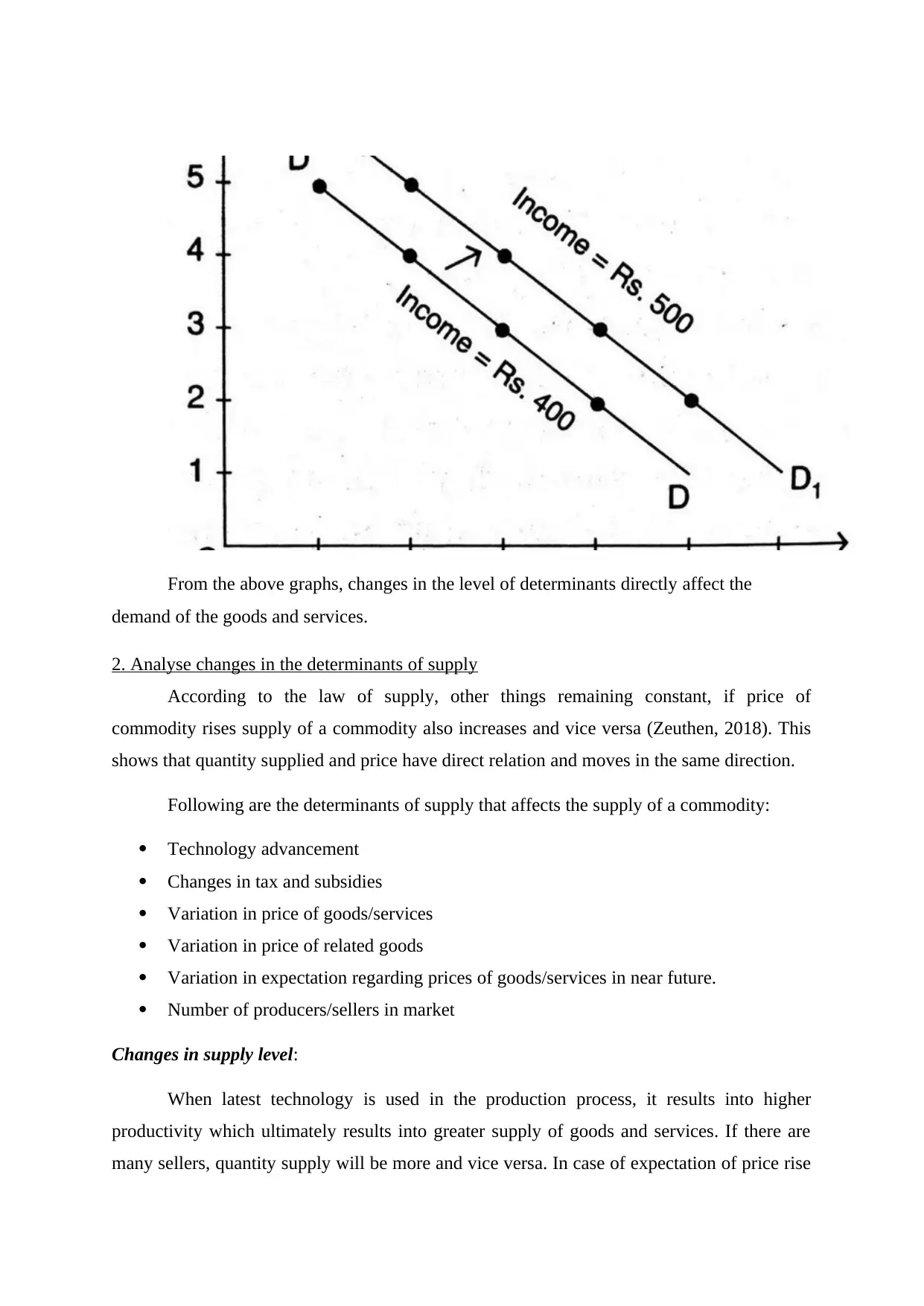
From the above graphs, changes in the level of determinants directly affect the
demand of the goods and services.
2. Analyse changes in the determinants of supply
According to the law of supply, other things remaining constant, if price of
commodity rises supply of a commodity also increases and vice versa (Zeuthen, 2018). This
shows that quantity supplied and price have direct relation and moves in the same direction.
Following are the determinants of supply that affects the supply of a commodity:
Technology advancement
Changes in tax and subsidies
Variation in price of goods/services
Variation in price of related goods
Variation in expectation regarding prices of goods/services in near future.
Number of producers/sellers in market
Changes in supply level:
When latest technology is used in the production process, it results into higher
productivity which ultimately results into greater supply of goods and services. If there are
many sellers, quantity supply will be more and vice versa. In case of expectation of price rise
demand of the goods and services.
2. Analyse changes in the determinants of supply
According to the law of supply, other things remaining constant, if price of
commodity rises supply of a commodity also increases and vice versa (Zeuthen, 2018). This
shows that quantity supplied and price have direct relation and moves in the same direction.
Following are the determinants of supply that affects the supply of a commodity:
Technology advancement
Changes in tax and subsidies
Variation in price of goods/services
Variation in price of related goods
Variation in expectation regarding prices of goods/services in near future.
Number of producers/sellers in market
Changes in supply level:
When latest technology is used in the production process, it results into higher
productivity which ultimately results into greater supply of goods and services. If there are
many sellers, quantity supply will be more and vice versa. In case of expectation of price rise
Paraphrase This Document
Need a fresh take? Get an instant paraphrase of this document with our AI Paraphraser
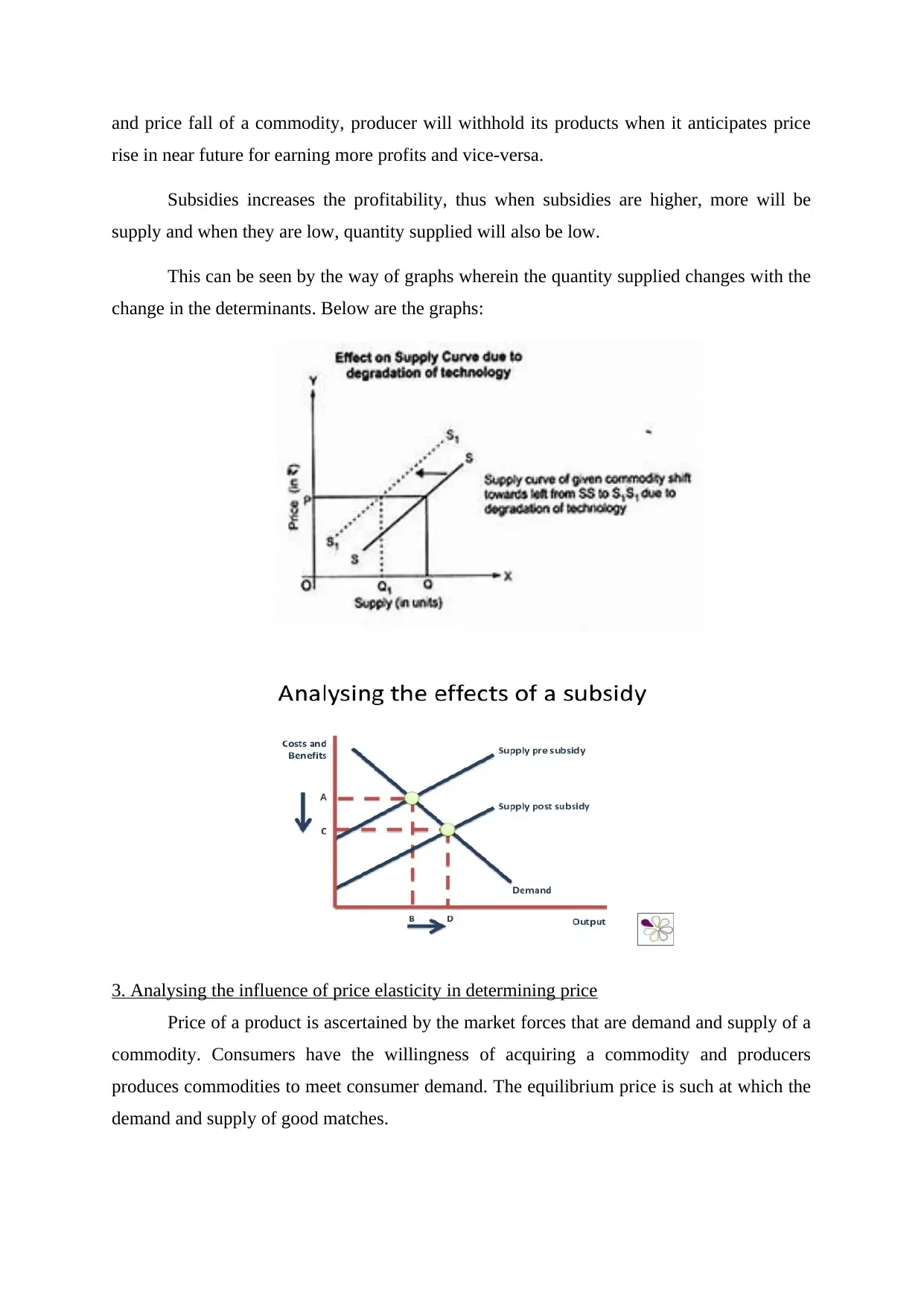
and price fall of a commodity, producer will withhold its products when it anticipates price
rise in near future for earning more profits and vice-versa.
Subsidies increases the profitability, thus when subsidies are higher, more will be
supply and when they are low, quantity supplied will also be low.
This can be seen by the way of graphs wherein the quantity supplied changes with the
change in the determinants. Below are the graphs:
3. Analysing the influence of price elasticity in determining price
Price of a product is ascertained by the market forces that are demand and supply of a
commodity. Consumers have the willingness of acquiring a commodity and producers
produces commodities to meet consumer demand. The equilibrium price is such at which the
demand and supply of good matches.
rise in near future for earning more profits and vice-versa.
Subsidies increases the profitability, thus when subsidies are higher, more will be
supply and when they are low, quantity supplied will also be low.
This can be seen by the way of graphs wherein the quantity supplied changes with the
change in the determinants. Below are the graphs:
3. Analysing the influence of price elasticity in determining price
Price of a product is ascertained by the market forces that are demand and supply of a
commodity. Consumers have the willingness of acquiring a commodity and producers
produces commodities to meet consumer demand. The equilibrium price is such at which the
demand and supply of good matches.
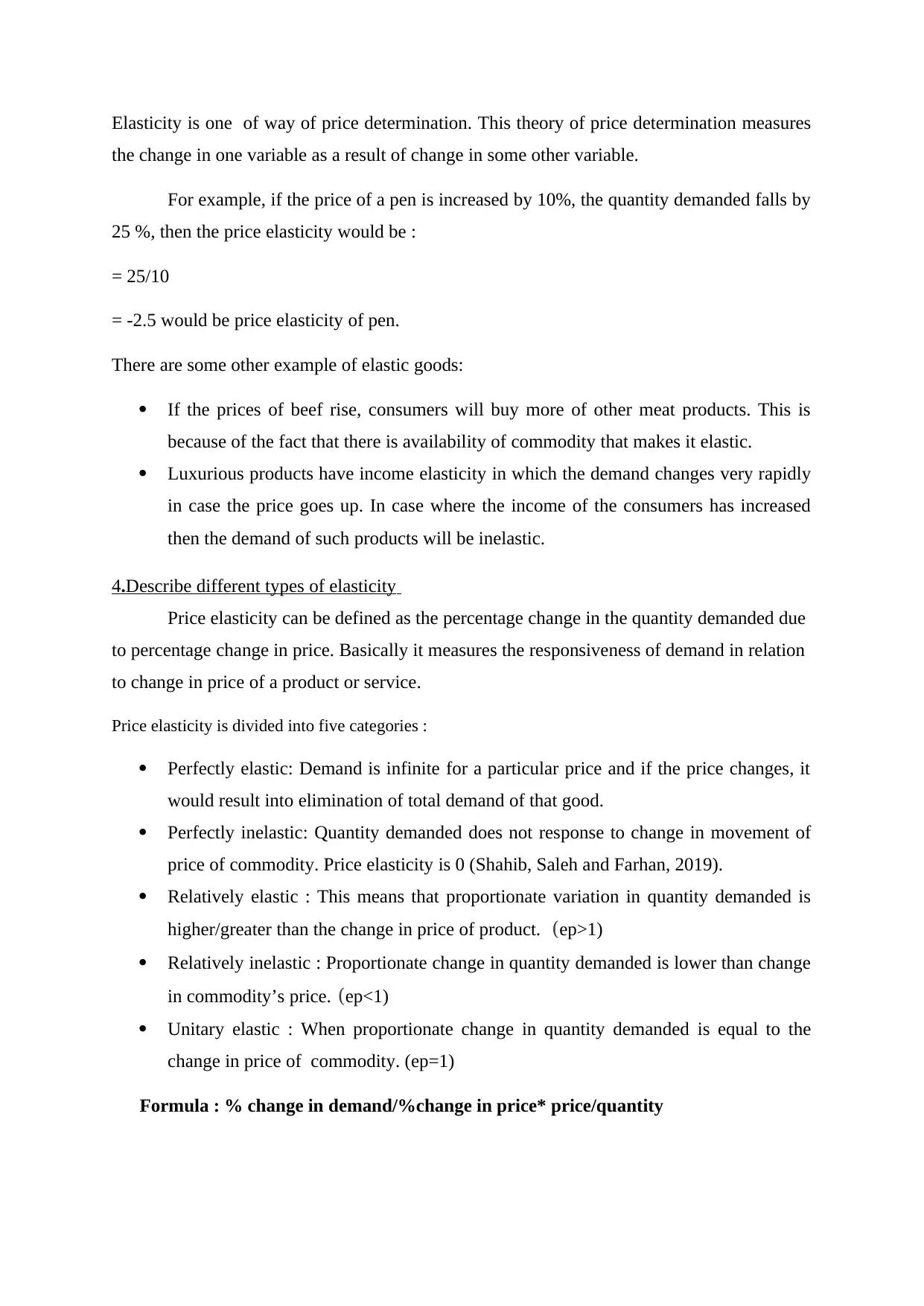
Elasticity is one of way of price determination. This theory of price determination measures
the change in one variable as a result of change in some other variable.
For example, if the price of a pen is increased by 10%, the quantity demanded falls by
25 %, then the price elasticity would be :
= 25/10
= -2.5 would be price elasticity of pen.
There are some other example of elastic goods:
If the prices of beef rise, consumers will buy more of other meat products. This is
because of the fact that there is availability of commodity that makes it elastic.
Luxurious products have income elasticity in which the demand changes very rapidly
in case the price goes up. In case where the income of the consumers has increased
then the demand of such products will be inelastic.
4.Describe different types of elasticity
Price elasticity can be defined as the percentage change in the quantity demanded due
to percentage change in price. Basically it measures the responsiveness of demand in relation
to change in price of a product or service.
Price elasticity is divided into five categories :
Perfectly elastic: Demand is infinite for a particular price and if the price changes, it
would result into elimination of total demand of that good.
Perfectly inelastic: Quantity demanded does not response to change in movement of
price of commodity. Price elasticity is 0 (Shahib, Saleh and Farhan, 2019).
Relatively elastic : This means that proportionate variation in quantity demanded is
higher/greater than the change in price of product. (ep>1)
Relatively inelastic : Proportionate change in quantity demanded is lower than change
in commodity’s price. (ep<1)
Unitary elastic : When proportionate change in quantity demanded is equal to the
change in price of commodity. (ep=1)
Formula : % change in demand/%change in price* price/quantity
the change in one variable as a result of change in some other variable.
For example, if the price of a pen is increased by 10%, the quantity demanded falls by
25 %, then the price elasticity would be :
= 25/10
= -2.5 would be price elasticity of pen.
There are some other example of elastic goods:
If the prices of beef rise, consumers will buy more of other meat products. This is
because of the fact that there is availability of commodity that makes it elastic.
Luxurious products have income elasticity in which the demand changes very rapidly
in case the price goes up. In case where the income of the consumers has increased
then the demand of such products will be inelastic.
4.Describe different types of elasticity
Price elasticity can be defined as the percentage change in the quantity demanded due
to percentage change in price. Basically it measures the responsiveness of demand in relation
to change in price of a product or service.
Price elasticity is divided into five categories :
Perfectly elastic: Demand is infinite for a particular price and if the price changes, it
would result into elimination of total demand of that good.
Perfectly inelastic: Quantity demanded does not response to change in movement of
price of commodity. Price elasticity is 0 (Shahib, Saleh and Farhan, 2019).
Relatively elastic : This means that proportionate variation in quantity demanded is
higher/greater than the change in price of product. (ep>1)
Relatively inelastic : Proportionate change in quantity demanded is lower than change
in commodity’s price. (ep<1)
Unitary elastic : When proportionate change in quantity demanded is equal to the
change in price of commodity. (ep=1)
Formula : % change in demand/%change in price* price/quantity
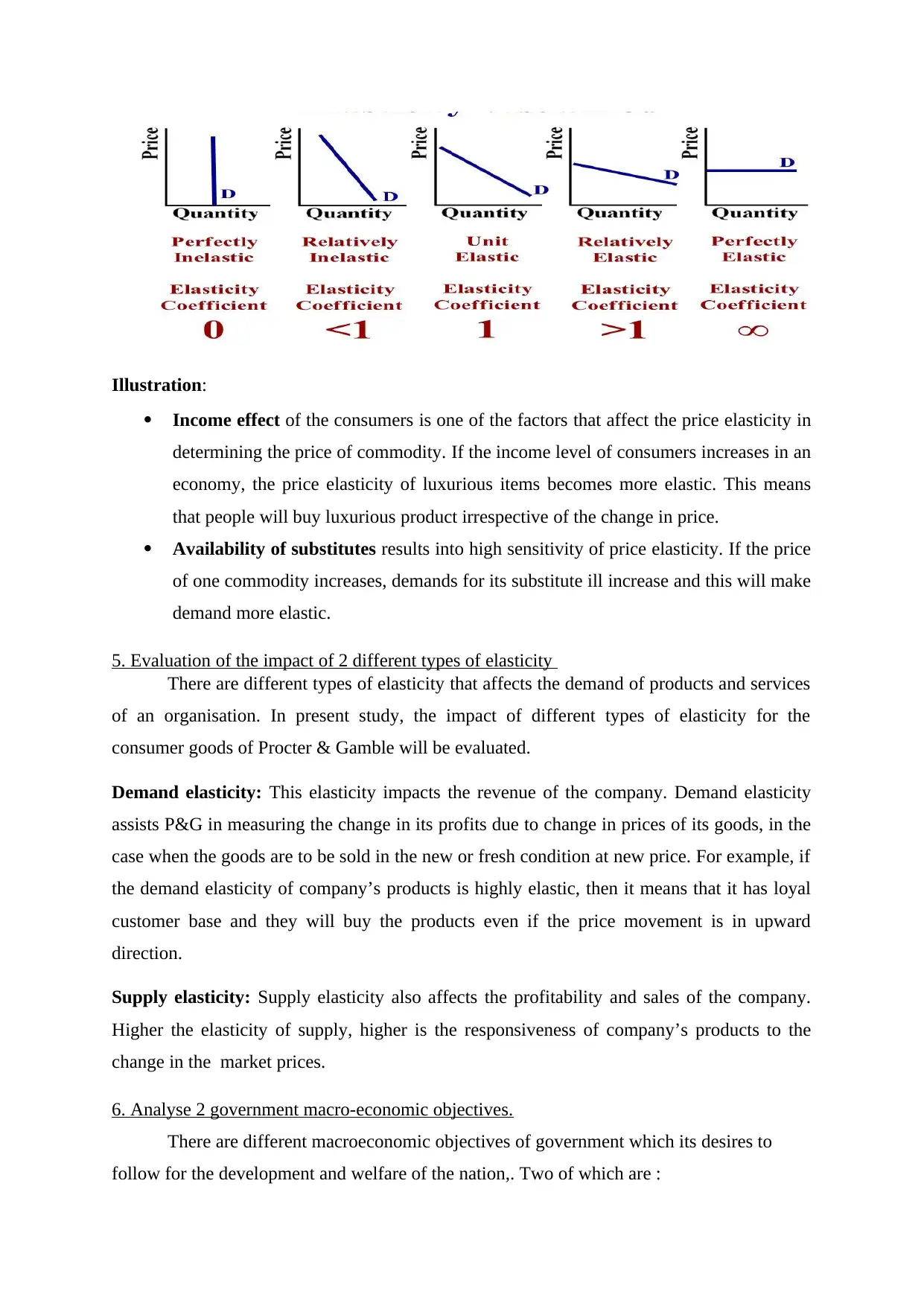
Illustration:
Income effect of the consumers is one of the factors that affect the price elasticity in
determining the price of commodity. If the income level of consumers increases in an
economy, the price elasticity of luxurious items becomes more elastic. This means
that people will buy luxurious product irrespective of the change in price.
Availability of substitutes results into high sensitivity of price elasticity. If the price
of one commodity increases, demands for its substitute ill increase and this will make
demand more elastic.
5. Evaluation of the impact of 2 different types of elasticity
There are different types of elasticity that affects the demand of products and services
of an organisation. In present study, the impact of different types of elasticity for the
consumer goods of Procter & Gamble will be evaluated.
Demand elasticity: This elasticity impacts the revenue of the company. Demand elasticity
assists P&G in measuring the change in its profits due to change in prices of its goods, in the
case when the goods are to be sold in the new or fresh condition at new price. For example, if
the demand elasticity of company’s products is highly elastic, then it means that it has loyal
customer base and they will buy the products even if the price movement is in upward
direction.
Supply elasticity: Supply elasticity also affects the profitability and sales of the company.
Higher the elasticity of supply, higher is the responsiveness of company’s products to the
change in the market prices.
6. Analyse 2 government macro-economic objectives.
There are different macroeconomic objectives of government which its desires to
follow for the development and welfare of the nation,. Two of which are :
Income effect of the consumers is one of the factors that affect the price elasticity in
determining the price of commodity. If the income level of consumers increases in an
economy, the price elasticity of luxurious items becomes more elastic. This means
that people will buy luxurious product irrespective of the change in price.
Availability of substitutes results into high sensitivity of price elasticity. If the price
of one commodity increases, demands for its substitute ill increase and this will make
demand more elastic.
5. Evaluation of the impact of 2 different types of elasticity
There are different types of elasticity that affects the demand of products and services
of an organisation. In present study, the impact of different types of elasticity for the
consumer goods of Procter & Gamble will be evaluated.
Demand elasticity: This elasticity impacts the revenue of the company. Demand elasticity
assists P&G in measuring the change in its profits due to change in prices of its goods, in the
case when the goods are to be sold in the new or fresh condition at new price. For example, if
the demand elasticity of company’s products is highly elastic, then it means that it has loyal
customer base and they will buy the products even if the price movement is in upward
direction.
Supply elasticity: Supply elasticity also affects the profitability and sales of the company.
Higher the elasticity of supply, higher is the responsiveness of company’s products to the
change in the market prices.
6. Analyse 2 government macro-economic objectives.
There are different macroeconomic objectives of government which its desires to
follow for the development and welfare of the nation,. Two of which are :
Secure Best Marks with AI Grader
Need help grading? Try our AI Grader for instant feedback on your assignments.

Price stability: Inflation can be defined as a sustained rise in the general level of prices which
is technically measured as the annual rate of change of the Retail Price Index (RPI). For
stabilising the prices in the nation, the inflation rate should be zero. Generally, it is
recommended to keep the inflation rate down to a low percentage. In United Kingdom,
stability of prices means slowly increase in the level of price by an average not exceeding 2
% per year (Stable prices, 2019). The Bank of England is bound to interfere in the
circumstances when the rate of inflation exceeds the above mentioned limits.
Economic growth: Another macroeconomic objective of the government is to accelerate the
economic growth of the country. Growth in the real GDP of the nations reflects the economic
health of the country. It is one of the primary objective of the country’s government because
economic growth is considered as a tool for eradicating the poverty. It also provides a
solution to the problem of unemployment pertaining in the country. It also enhances the
productivity level in the United Kingdom. Further, it increases the standard of living of the
citizens of the nation by providing them employment through which people can earn the basic
amenities of life. Budget deficit is also improved through economic growth (den Haan and
et.al., 2017).
7. Role of monetary and fiscal policies in regulating the gross domestic growth
Monetary policy is the process through which the monetary authorities i.e. the central
bank or currency board, controls the cost of short-term borrowing or the money supply,
targeting inflation or the interest rate to secure price stability and trust in the currency. Fiscal
policy is the way by which a government controls its spending levels and tax rates to observe
and influence a nation's economy. It is the bounded strategy with monetary policy through
which a central bank affects nation’s supply of money (Jones and Fuller, 2015).
Goals of a monetary and fiscal policy are to contribute for the stability of gross
domestic product, to achieve and maintain low unemployment, and to stabilize
predictable exchange rates with other currencies. These policies are concerned with
controlling inflation and credit in the economy which eventually helps in regulating and
enhancing gross domestic growth.
CONCLUSION
From the above project report, it can be summarised that economic environment of
the country is concerned with creation, consumption and development of wealth. It was seen
is technically measured as the annual rate of change of the Retail Price Index (RPI). For
stabilising the prices in the nation, the inflation rate should be zero. Generally, it is
recommended to keep the inflation rate down to a low percentage. In United Kingdom,
stability of prices means slowly increase in the level of price by an average not exceeding 2
% per year (Stable prices, 2019). The Bank of England is bound to interfere in the
circumstances when the rate of inflation exceeds the above mentioned limits.
Economic growth: Another macroeconomic objective of the government is to accelerate the
economic growth of the country. Growth in the real GDP of the nations reflects the economic
health of the country. It is one of the primary objective of the country’s government because
economic growth is considered as a tool for eradicating the poverty. It also provides a
solution to the problem of unemployment pertaining in the country. It also enhances the
productivity level in the United Kingdom. Further, it increases the standard of living of the
citizens of the nation by providing them employment through which people can earn the basic
amenities of life. Budget deficit is also improved through economic growth (den Haan and
et.al., 2017).
7. Role of monetary and fiscal policies in regulating the gross domestic growth
Monetary policy is the process through which the monetary authorities i.e. the central
bank or currency board, controls the cost of short-term borrowing or the money supply,
targeting inflation or the interest rate to secure price stability and trust in the currency. Fiscal
policy is the way by which a government controls its spending levels and tax rates to observe
and influence a nation's economy. It is the bounded strategy with monetary policy through
which a central bank affects nation’s supply of money (Jones and Fuller, 2015).
Goals of a monetary and fiscal policy are to contribute for the stability of gross
domestic product, to achieve and maintain low unemployment, and to stabilize
predictable exchange rates with other currencies. These policies are concerned with
controlling inflation and credit in the economy which eventually helps in regulating and
enhancing gross domestic growth.
CONCLUSION
From the above project report, it can be summarised that economic environment of
the country is concerned with creation, consumption and development of wealth. It was seen

that there are different determinants of demand and supply that results into changes in the
quantity demanded and quantity supplied. Further, it was seen that monetary and fiscal
polices are two sister polices that helps in regulating gross domestic growth by stabilising the
prices and controlling the credit.
quantity demanded and quantity supplied. Further, it was seen that monetary and fiscal
polices are two sister polices that helps in regulating gross domestic growth by stabilising the
prices and controlling the credit.
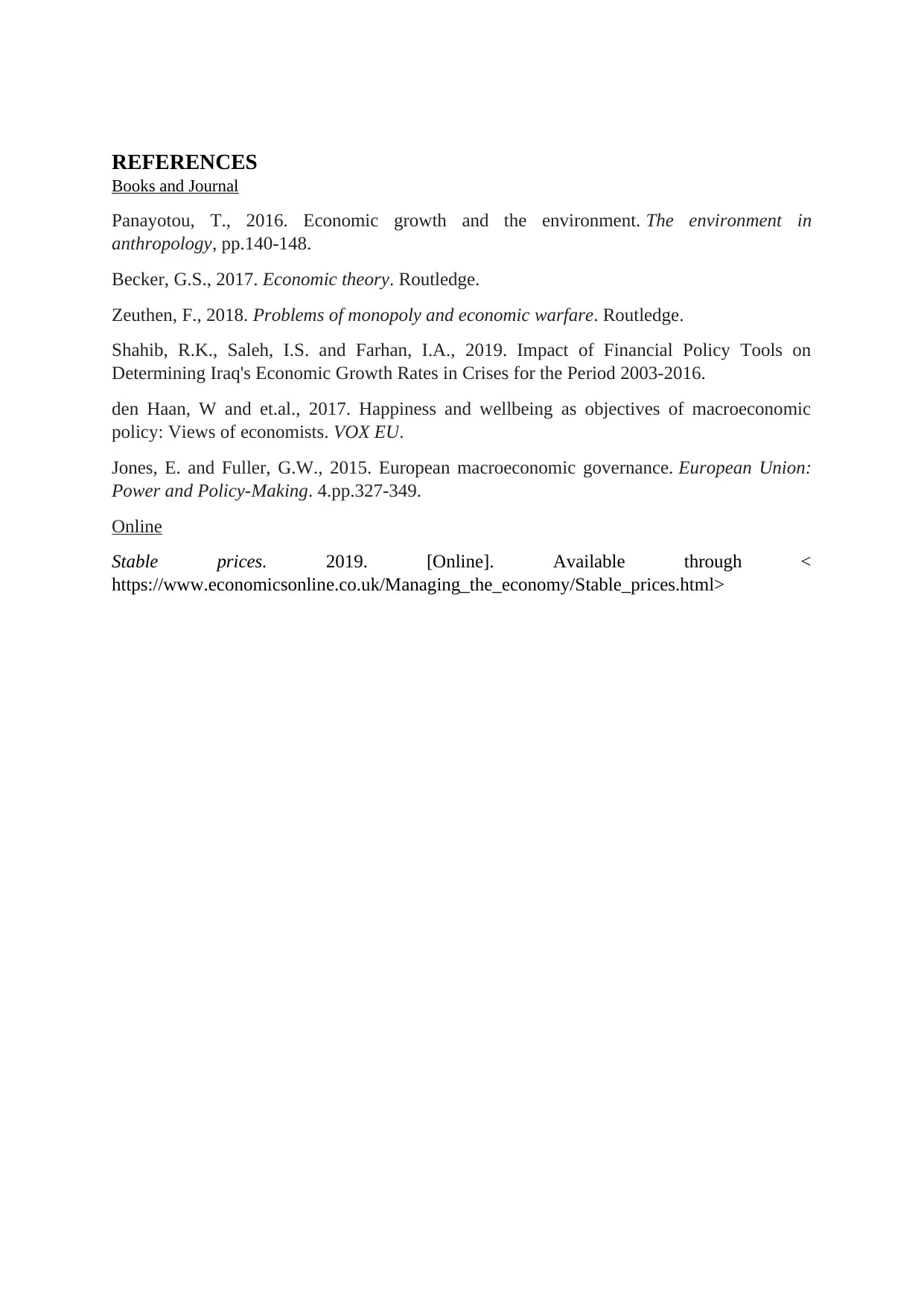
REFERENCES
Books and Journal
Panayotou, T., 2016. Economic growth and the environment. The environment in
anthropology, pp.140-148.
Becker, G.S., 2017. Economic theory. Routledge.
Zeuthen, F., 2018. Problems of monopoly and economic warfare. Routledge.
Shahib, R.K., Saleh, I.S. and Farhan, I.A., 2019. Impact of Financial Policy Tools on
Determining Iraq's Economic Growth Rates in Crises for the Period 2003-2016.
den Haan, W and et.al., 2017. Happiness and wellbeing as objectives of macroeconomic
policy: Views of economists. VOX EU.
Jones, E. and Fuller, G.W., 2015. European macroeconomic governance. European Union:
Power and Policy-Making. 4.pp.327-349.
Online
Stable prices. 2019. [Online]. Available through <
https://www.economicsonline.co.uk/Managing_the_economy/Stable_prices.html>
Books and Journal
Panayotou, T., 2016. Economic growth and the environment. The environment in
anthropology, pp.140-148.
Becker, G.S., 2017. Economic theory. Routledge.
Zeuthen, F., 2018. Problems of monopoly and economic warfare. Routledge.
Shahib, R.K., Saleh, I.S. and Farhan, I.A., 2019. Impact of Financial Policy Tools on
Determining Iraq's Economic Growth Rates in Crises for the Period 2003-2016.
den Haan, W and et.al., 2017. Happiness and wellbeing as objectives of macroeconomic
policy: Views of economists. VOX EU.
Jones, E. and Fuller, G.W., 2015. European macroeconomic governance. European Union:
Power and Policy-Making. 4.pp.327-349.
Online
Stable prices. 2019. [Online]. Available through <
https://www.economicsonline.co.uk/Managing_the_economy/Stable_prices.html>
Paraphrase This Document
Need a fresh take? Get an instant paraphrase of this document with our AI Paraphraser

1 out of 11
Related Documents
Your All-in-One AI-Powered Toolkit for Academic Success.
+13062052269
info@desklib.com
Available 24*7 on WhatsApp / Email
![[object Object]](/_next/static/media/star-bottom.7253800d.svg)
Unlock your academic potential
© 2024 | Zucol Services PVT LTD | All rights reserved.




